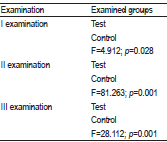Influence of motion therapy on daily life activities of people with lumbar pain syndrome
DOI:
https://doi.org/10.17532/jhsci.2022.1975Keywords:
Daily life activities, lumbar pain syndrome, motion therapy, muscle strengthening exercises, Oswestry disability index, spine mobility exercisesAbstract
Introduction: Lumbar pain syndrome (LPS) is defined as pain or discomfort localized between the edge of the twelfth rib and the lower gluteal region, with or without spread to the lower extremities, and, depending on the etiology and degree of symptomatology, can have negative consequences and be one of the main reasons for work disability and absenteeism worldwide. The aim of this study was to determine the impact of exercise therapy on the activities of daily living of a person with LPS.
Methods: This prospective, longitudinal, and randomized controlled trial was conducted from June 2014 to June 2016. It included 200 subjects with symptoms of LPS, both sexes, aged 30 to 50 years, sedentary and standing occupations, randomized and equally divided into two groups: Examined (n = 100) and the control group (n = 100). In this study, the Oswestry Low Back Pain Disability Questionnaire was used after clinical examination.
Results: The percentage of disability according to the Oswestry disability index at the first examination was 31.78 ± 14.11% in the participants of the test group and 38.74 ± 17.48% in the participants of the control group (p = 0.002). After the second examination, the percentage of disability was 6.64 ± 3.15% in the test group and 23.92 ± 14.84% in the control group (p = 0.001). At the end of the examination, the percentage of disability was 2.36 ± 0.78% in the subjects of the test group and 13.82 ± 11.25% in the subjects of the control group (p = 0.001). A statistically significant difference was found in all three examinations, and the reduction in the percentage of disability was greater in the study group, p < 0.05.
Conclusion: The research conducted showed that motion therapy procedures focused on achieving natural spinal mobility and improving trunk muscle strength are effective in reducing
Downloads

Downloads
Published
License
Copyright (c) 2022 Eldad Kaljić, Arzija Pašalić, Bakir Katana, Amra Mačak Hadžiomerović, Samir Bojičić, Amila Jaganjac, Naim Salkić

This work is licensed under a Creative Commons Attribution 4.0 International License.










